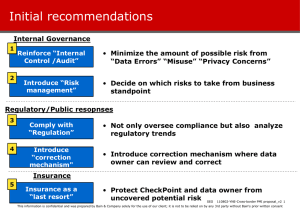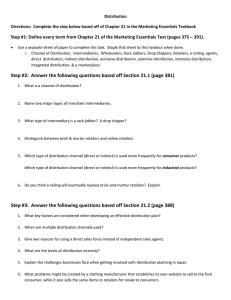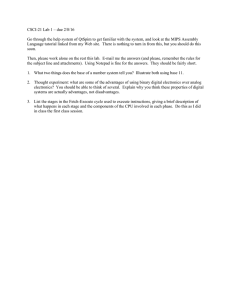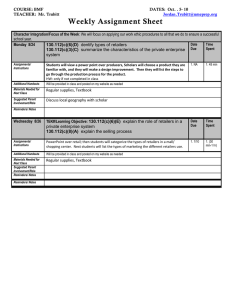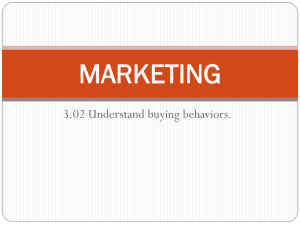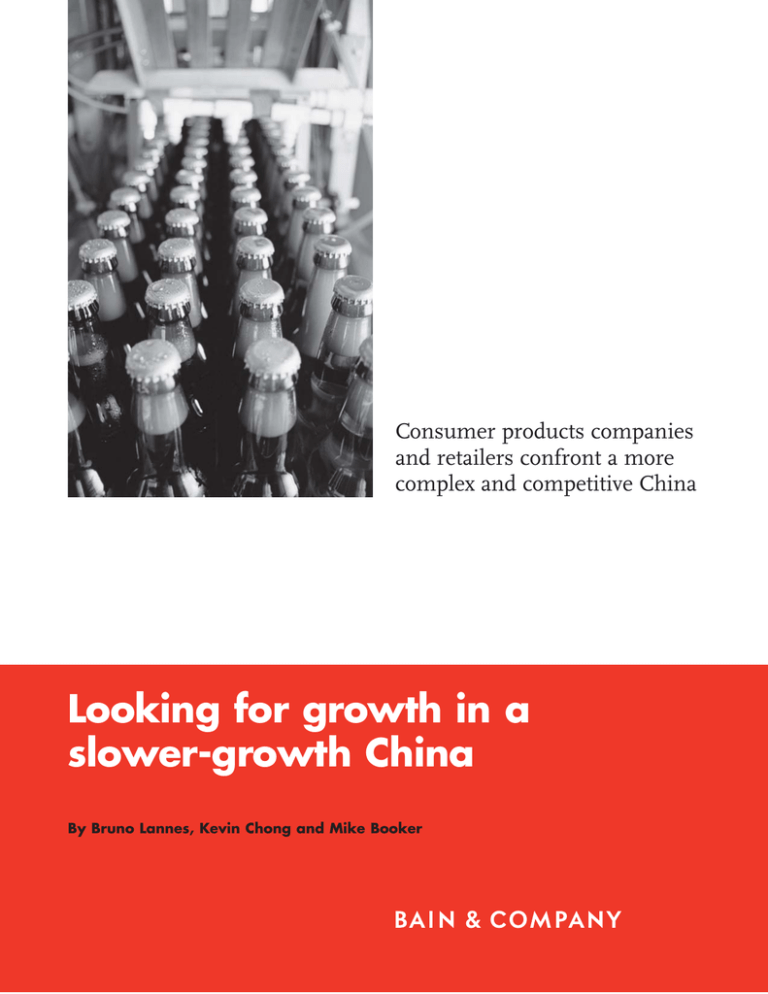
Consumer products companies
and retailers confront a more
complex and competitive China
Looking for growth in a
slower-growth China
By Bruno Lannes, Kevin Chong and Mike Booker
Bruno Lannes, partner, leads Bain & Company’s Consumer Products and Retail
practices in Greater China. Kevin Chong is a manager in Bain & Company’s
Shanghai office. Mike Booker, a partner based in Singapore, leads Bain &
Company’s Asia-Pacific Consumer Products and Retail practices.
Copyright © 2009 Bain & Company, Inc. All rights reserved.
Content: Editorial team
Layout: Global Design
Looking for growth in a slower-growth China
Consumer products
companies and retailers
confront a more complex
and competitive China
As the financial crisis swept across the globe,
China defied recessionary pressures and
continued to grow. Although the pace has cooled
from explosive double-digit rates, many
forecasters are predicting that the emerging
market titan may be the first major economy
to accelerate out of the downturn. But even if
China does rebound, spurred by the government’s $586 billion stimulus package, the
storm is far from over. Consumer products
makers and retailers are confronting a reshaped
landscape, one that is both more complex
and brutally competitive.
Fast-Moving Consumer Goods (FMCG)
companies and the retailers who sell their
products have long known that, given the country’s
vast regional differences, they never could rely
on a one-size-fits-all approach to expansion in
China. But now, as the dust from the downturn
begins to settle, those differences have come
into sharper focus. Export-dependent coastal
cities like Ningbo and Shenzhen now struggle
with consolidation in the once-booming retail
sector while those same retailers implement
ambitious expansion plans to serve the fastgrowing middle class in central and western
China. The new environment calls for consumer
goods companies and retailers to become far
more strategic than ever as they readjust their
expansion plans, paying renewed attention to
each market’s subtleties and potential for
profitable growth.
For many companies, China’s less impacted
regions are the best bet for growth—this includes
many of the country’s more than 1,500 Tier 2
and Tier 3 cities as well as cities in central and
western China, where middle-class consumers
now have more discretionary money to spend
(See Figure 1). As competition has intensified
in the biggest cities, these cities—120 of them
with populations over one million—provide
a lucrative new arena for well-established
multinationals selling necessities like toothpaste,
laundry detergent and other household items.
But there are a couple of complicating factors.
For one thing, while some categories are wide
open, others—beer is an example—have become
the domain of formidable domestic competitors.
And in these cities where much of the growth
will occur, domestic companies may have a
competitive edge over multinationals when it
comes to supplier and distributor networks;
they can capitalize on established networks to
feed their expansions while foreigners would
have to invest heavily to catch up.
Figure 1: Economic impact in China differs
by geography
Percent of consumers that feel less confident about economy
60%
Shenzhen
Guangdong
54%
Zhejiang
54%
Jiangsu
South & East
consumer
confidence
more impacted
52%
Yunan
43%
Jilin
43%
Sichuan
42%
Heilongjiang
42%
0
South
20
East
40
North & West
consumer
confidence
less impacted
60
West
80%
North
Tsingtao
Sales in GZ and Eastern cities declined significantly
in Q408 (by as much as 20%–30% in some cities)
Home Inn
Occupancy rates in Q408 declined by 4% in
SH/BJ/GZ cities, declined by 2% in Tier 2 cities
but increased by 6% in smaller cities
LiNing
Strong same store sales growth in Tier 3 cities
in West and Central regions, weakening growth
in the South
*Home Inn Tier 2 cities include province capital cities and 9 other big cities,
e.g., SZ, NB and DL
Source: Millward Brown ACSR and Light Speed survey (N=11,300, NovDec 2008,
collected in 23 provinces); Analyst reports
1
Looking for growth in a slower-growth China
With so many variables in play, knowing where
you can head in tomorrow’s China starts with
knowing where you stand today. Companies
that succeed in the post-downturn climate will
be those that understand the opportunities
created or limited by their competitive position—
especially against domestic players—and the
implications of how their category is faring. For
example, a market leader in a relatively stable
category like shampoo would approach expansion
quite differently than a weak player in a
severely impacted category like luxury watches.
It also has launched a premium draft beer to
improve its product mix and continued its
national brand-building campaign, outspending
Tsingtao’s CCTV advertising by three to one. To
increase profitability, the company has raised
prices and reduced the bottle size in target
markets, including Hangzhou, Sichuan and
Jilin. Meanwhile, Snow has invested heavily to
gain access to important wholesalers and obtain
exclusive deals with retailers. To improve its cost
position, the brewer has centralized procurement
and invested in better inventory management.
Here’s how both retailers and consumer
products companies have used their market
position to dictate expansion plans for a slowergrowth China, making the most of opportunities
in the areas of customers, channels, competitors
and costs.
These moves have paid off handsomely for Snow,
with beer sales volumes increasing 20 percent
while revenues have grown 25 percent in the first
half of 2009, enabling the company to accelerate out of the downturn stronger than ever.
Challenger in a growing category
Leader in a growing category
Household necessities and affordable indulgences
have held up well across the country and are
likely to continue growing in the post-downturn
market. Leaders like Procter & Gamble, Kraft
and L’Oreal have taken advantage of the
economic turbulence to grab market share from
weaker competitors through aggressive marketing,
pursuing untapped customer segments, increasing
profits through efficiencies and, where they
can, acquiring struggling companies.
Take Snow, China’s number-one selling beer, a
joint venture between China Resource Enterprise
Ltd and SABMiller. The Chinese brewery has
capitalized on the financial crisis by using
acquisitions to pick off smaller rivals and
expanding into areas that both build on its local
leadership position and penetrate competitors’
territory. In the spring, Snow acquired four beer
makers, including Shandong-based Amber
Breweries, a move that gives it a foothold in the
province where arch rival Tsingtao dominates.
2
In relatively unscathed categories like beer, snack
foods and home-care products, challengers to
the market leaders are best served by staying
the course in their pursuit of new growth. They
should continue doing what’s proven successful
in brand building, consumer promotions,
penetrating channels and reducing costs.
Companies in this position include Tsingtao, a
major competitor to Snow, oral-care product
maker Darlie and Kangshifu (KSF), a leader
in beverages, instant noodles and biscuits. In
biscuits, KSF’s strategy is to ratchet up efforts
to gain on top-selling Kraft, while at the same
time fending off encroaching foreign competitors.
To win over customers, KSF is teaming with
celebrity endorsers to increase brand awareness
among younger consumers as well as sponsoring
student music festivals and online games. To
grow share, the company has offered value packs
and bundled products. KSF is also beefing up
its already strong network of suppliers and
distributors to help it expand into fast-growing
rural areas. And to reduce costs, the tech-savvy
Looking for growth in a slower-growth China
Figure 2: Case study of companies’ response to the new environment
High
(hardhit category)
• B&Q (downsizing and repositioning)
– Downsizing to reduce cost
– Reposition stores to capture
consumer trends
– Heavy promotions to attract customers
Examples: Electronics (BenQ, Electrolux),
international spirits (BrownForman)
• Suning (build on strengths)
– Continue aggressive expansion of
new outlets
– Improve product mix and focus on
highprofit items
– Store renovations, promotions and
increased services to attract customers
Examples: Computers (Lenovo), electronics (Haier),
international spirits (Pernod Ricard), luxury (LVMH)
Impact on
the industry
• KSF (continue previous strategy)
– Continue what has been successful in
brand building, consumer promotion,
channel penetration and cost reduction
Examples: Beer (Tsingtao), oral care (Darlie)
Low
(lessimpacted
category)
• Snow (capitalize on the crisis)
– M&A to strengthen local leadership
position and penetrate competitors’ territories
– Continue to invest in brand building
and control over distributors and retailers
– Improve profitability through premium
product, raising prices and
improving cost position
Examples: Biscuit (Kraft), oral care (P&G)
Challenger
Leader
Market position
company has relied heavily on its information
technology system to improve the efficiency
of its manufacturing, distribution centers and
sales networks. The company’s biscuit business
saw strong revenue growth of 14.5 percent in
the first half of 2009. Operating profit margins
have more than doubled from less than 4 percent
in the first half of 2008 to more than 9 percent
in the first half of 2009.
Leader in a hard-hit category
In severely impacted product categories like
consumer electronics and high-end luxury
goods, market leaders looking for growth know
they must do more than simply hold onto existing
customers. They must capitalize on the crisis
to grab market share. Companies like Suning,
Haier and Pernod Ricard implement strategies
that build on the strengths that made them
industry leaders, while at the same time exploiting
competitors’ weaknesses. To boost sales and
customer loyalty and at the same time target
new customers, they beef up branding and
distribution, focus on value offerings that get
shoppers in the door, run targeted promotions
and discounts, and constantly look for ways
to reduce the cost structure.
For Suning Appliances, the good news is that
it has established itself as a leading electronics
retailer. The bad news is that appliance sales
have dropped dramatically in its biggest markets,
9 percent in the first three months of 2009
alone. But while sales in its Tier 1 city stores
plunged, Suning was able to increase profits
48 percent in 2008 and 15 percent in the first
half of 2009 because the rest of its stores held
up. Just as the downturn started to be felt
elsewhere in China, the company began mapping
3
Looking for growth in a slower-growth China
out a strategy to make the most of the changing
market: aggressively expand, improve its
product mix, renovate stores and use increased
services as a lure to attract new customers.
To shift the focus to high-profit items, Suning
started prominently displaying high-margin
consumer electronics items near store entrances.
The maneuver worked, boosting sales of computers alone by 30 percent.
Expansion plans call for opening more than 200
stores in 2009, part of Suning’s efforts to
undercut the dominance of troubled Gome
Electrical Appliances. To cash in on a government
rebate program that encourages the purchase
of household appliances, Suning is rapidly
rolling out stores in rural areas. Over the next
five years, Suning’s master plan calls for opening at least 1,000 new stores. And Suning is
moving into the Japanese market, with plans to
purchase a majority stake in Laox, a struggling
Japanese electronics retailer, giving it access to
Japanese consumer electronics retail experience
and to Japanese games and toys suppliers.
Challenger in a hard-hit category
Weak players in hard-hit categories like
consumer electronics, premium liquor and home
improvement face the fewest options in the
post-downturn economy. Among the companies in
this position: consumer electronics competitors
BenQ and Electrolux, imported spirits maker
Brown-Forman and UK-based home improvement giant B&Q. For these and other companies,
plotting a future means downsizing to reduce
costs, repositioning to capture consumer trends
and promoting heavily to attract customers.
B&Q opened its largest store in Shanghai amid
great promise on the date 8/8—a lucky number
combination in China—in 2001, but now is
paying a heavy price for expanding too rapidly
4
in the country. The retailer is burdened with
oversized stores selling too many items and
sometimes the wrong products for the markets.
To recover, B&Q is taking some dramatic steps.
To offset losses in 2008, B&Q plans to close
almost a third of its Chinese stores and downsize others. It’s cutting costs by scaling back,
cashing in on new market trends and increasing
sales with heavy promotions featuring discounts
of up to 40 percent. From a smaller base, B&Q
is pegging its future on a new approach to
expansion. Its first “B&Q Next Generation
Store,” which opened in March in Shanghai,
is more modern, more user-friendly and geared
to female customers, in recognition of the fact
that women often make the decisions about
home improvement purchases.
For B&Q, and other retailers and consumer
products companies operating in China,
capturing one’s share of a slower-growth
future starts by understanding that competitive
position and industry stability dictate how to
plot your moves. And as growth accelerates,
particularly in the North and West, and in
smaller cities throughout China, it requires
carefully seeking out the pockets of opportunity
that have replaced a booming free-for-all.
Looking for growth in a slower-growth China
Bain’s business is helping make companies more valuable.
Founded in 1973 on the principle that consultants must measure their success in terms
of their clients’ financial results, Bain works with top management teams to beat competitors
and generate substantial, lasting financial impact. Our clients have historically outperformed
the stock market by 4:1.
Who we work with
Our clients are typically bold, ambitious business leaders. They have the talent, the will
and the open-mindedness required to succeed. They are not satisfied with the status quo.
What we do
We help companies find where to make their money, make more of it faster and sustain
its growth longer. We help management make the big decisions: on strategy, operations,
technology, mergers and acquisitions and organization. Where appropriate, we work with
them to make it happen.
How we do it
We realize that helping an organization change requires more than just a recommendation.
So we try to put ourselves in our clients’ shoes and focus on practical actions.
For more information, please visit www.bain.com

